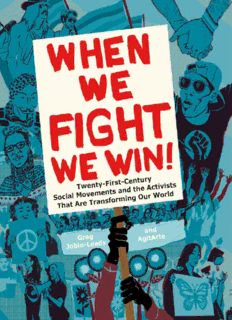
When We Fight, We Win: Twenty-First-Century Social Movements and the Activists That Are Transforming Our World PDF
Preview When We Fight, We Win: Twenty-First-Century Social Movements and the Activists That Are Transforming Our World
© 2016 by Greg Jobin-Leeds Foreword © 2016 by Rinku Sen Afterword © 2016 by Antonia Darder All rights reserved. No part of this book may be reproduced, in any form, without written permission from the publisher. “Hard Time Out” by David Goodman (pages 63–64) was previously published in Mother Jones, August 2008. Reprinted by permission of the author. Photographs on pages 171–173 by Osvaldo Budet Requests for permission to reproduce selections from this book should be mailed to: Permissions Department, The New Press, 120 Wall Street, 31st floor, New York, NY 10005. Published in the United States by The New Press, New York, 2016 Distributed by Perseus Distribution LIBRARY OF CONGRESS CATALOGING-IN-PUBLICATION DATA Jobin-Leeds, Greg, author. When we fight, we win!: twenty-first-century social movements and the activists that are transforming our world/Greg Jobin-Leeds, pages cm Includes bibliographical references and index. ISBN 978-1-62097-140-6 (e-book) 1. Social reformers--United States. 2. Political activists--United States. 3. Social action--United States--History--21st century. 4. Social movements--United States--History--21st century. I. Title. HN59.2.J625 2016 303.48’40973--dc23 2015022368 The New Press publishes books that promote and enrich public discussion and understanding of the issues vital to our democracy and to a more equitable world. These books are made possible by the enthusiasm of our readers; the support of a committed group of donors, large and small; the collaboration of our many partners in the independent media and the not-for-profit sector; booksellers, who often hand-sell New Press books; librarians; and above all by our authors. www.thenewpress.com Book design by AgitArte Printed in the United States of America 10 9 8 7 6 5 4 3 2 1 To all the activists and artists in this book, and my parents, Lilo Leeds and Gerry Leeds (1922–2014), for showing us how to fight for what we love, and, no matter how dark the times, how to win our humanity “Radicals are in many ways social artists. They restate the hidden truths of society through working with people and social movements. . . . They teach people to see with a fresh vision . . . laying bare the full absurdities of treasured hypocrisies.” Judith Nies, author of Nine Women: Portraits from the American Radical Tradition “If there is no struggle, there is no progress. Those who profess to favor freedom, and yet deprecate agitation, are men who want crops without plowing up the ground. They want rain without thunder and lightning. They want the ocean without the awful roar of its many waters. . . . Power concedes nothing without a demand. It never did and it never will.” Frederick Douglass, author and slavery abolitionist, 1857 CONTENTS FOREWORD BY RINKU SEN INTRODUCTION: INSPIRATION FROM STORIES 1. RECLAIMING WHOLENESS: THE LGBTQ MOVEMENT 2. GROUNDED IN COMMUNITY: THE FIGHT FOR THE SOUL OF PUBLIC EDUCATION 3. TRANSFORMING VISIONS: ENDING MASS INCARCERATION 4. THE POWER OF STORIES: THE DREAMERS AND IMMIGRANT RIGHTS 5. “WHEN WE FIGHT, WE WIN!”: THE STRUGGLE FOR ECONOMIC POWER 6. ENVIRONMENTAL WARRIORS: GOING TO THE ROOT OF THE PROBLEM EPILOGUE: SOLIDARITY—A GATHERING AFTERWORD: STORIES OF LOVE AND FURY BY ANTONIA DARDER DESIGNERS’ NOTE BY AGITARTE ACKNOWLEDGMENTS THE WHEN WE FIGHT, WE WIN! TEAM NOTES INDEX FOREWORD RINKU SEN By the time I discovered racial justice organizing at the age of seventeen, the social movements of the 1960s had waned. Sit-ins and protests had given way to the work that comes after victory: implementing the many changes brought into being by the civil rights, black power, women’s, and peace movements. My generation was the first to benefit from those changes. Indeed, I owe my very presence in the United States, and thus my identity as an American, to a historic piece of legislation reflecting the anti-discrimination ethos that pushed this country forward in 1965. The civil rights movement and power movements among black, brown, red, and yellow people had successfully asserted equal treatment as an American value. I’ve devoted my whole adult life to figuring out how to create social movements of a similar scope and depth. When I started on this road in the mid-1980s, I didn’t realize that a mere twenty years had been more than enough to craft a distorted popular retelling of movement history, and to establish that distortion as fact. The political stories I heard as a child featured deeply misleading “lessons” about massive social progress sparked by individual acts of heroic resistance. Before I knew better, what people called “movements” often seemed to have been led by exceptional charismatic men, working in concert with other exceptional charismatic men. These were fantasy versions of movements, in which the mundane was deleted in favor of the dramatic, and the collective in favor of the individual. Popular movement stories also frequently delete the poor, the female, the queer, and the nonwhite. To get access to the full range of questions and answers, to the reflections that would actually help me act in ways that fostered movement, I had to push past revision to get to reality. I busted through this fiction in no small part by reading books like When We Fight, We Win! The world and the United States are unquestionably in a turbulent time, as communities rise up to assert their right not only to exist but also to thrive with every expectation of safety and self-determination. In 2014 and 2015, thousands of demonstrators have taken to the streets in Ferguson, Baltimore, and too many other places to count, facing down tear gas and tanks while protesting the systemic inaction that enabled yet another police killing of an unarmed black teenager. In these pages, we see Native Americans reminding the nation that they are still here and still fighting. We meet people who are stretching and bending the
Description: